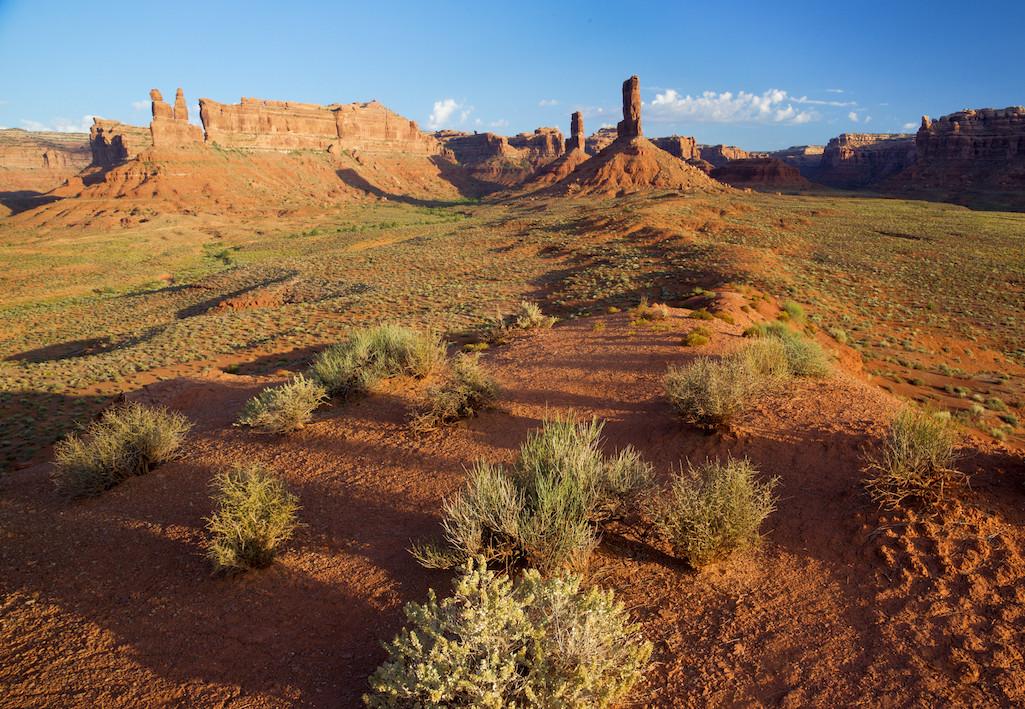
A coalition of conservation groups has moved to intervene in a legal battle over the boundaries of Bears Ears and Grand Staircase-Escalante national monuments in Utah/BLM, Valley of the Gods in the southern end of Bears Ears, Bob Wick
A coalition of conservation groups has moved to intervene in the legal battle over Bears Ears and Grand Staircase-Escalante national monuments in Utah, joining tribal nations that also are challenging two lawsuits that seek to reverse the monuments' boundaries.
At issue are lawsuits the state of Utah and two of its counties filed in U.S. District Court last August in a bid to overturn the latest boundary change to the two monuments, arguing that President Biden overreached the authority given him under The Antiquities Act when he restored the monuments' original boundaries as set by Presidents Clinton and Obama.
“These lawsuits seek to destroy The Antiquities Act with a flawed argument that presidents may only designate small monuments,” said Heidi McIntosh, Earthjustice managing attorney representing the conservation groups. “The Supreme Court has recognized for 100 years that The Antiquities Act gives the president broad authority to designate national monuments commensurate in size to the ‘objects’ that need protection. Lower courts have consistently followed suit. Without the Antiquities Act, we would not have some of our most beloved national parks, including Grand Canyon, Grand Teton, Olympic, Zion, and Acadia. We will fight alongside our partners and clients to ensure the Antiquities Act is preserved for future generations to experience our most beloved and historic places.”
Bears Ears National Monument was established by President Obama in 2016 under The Antiquities Act following years of advocacy by numerous tribes with cultural ties to the land. The Bears Ears Inter-Tribal Coalition advocated successfully to protect the cultural, historic, and natural values of the monument. The monument is home to multiple culturally significant and archaeological sites dating as far back as 11,000 BCE. The land is still used today by tribal members, who continually visit it to conduct religious ceremonies and other traditional practices.
The 1.9-million-acre Grand Staircase-Escalante National Monument, designated by President Clinton in 1996, is extremely rich in paleontological resources, with nearly 150 scientists having said the monument “hosts one of the highest concentrations of dinosaur fossils in the world,” and that only 6 percent has been surveyed, and that “the potential for future discovery is tremendous.”
But former President Trump flew to Salt Lake City in December 2017 to issue presidential proclamations that sheared nearly 2 million acres from the two monuments. Trump maintained that Clinton and Obama overreached their authority under The Antiquities Act by creating national monuments larger than needed to protect historic, cultural, archaeological, and paleontological resources.
Last week the Hopi Tribe, Navajo Nation, Ute Mountain Ute Tribe, and the Pueblo of Zuni moved to intervene in the suits.
In 1920, the Supreme Court upheld President Teddy Roosevelt’s use of the Antiquities Act to protect 800,000 acres in Arizona when he declared the Grand Canyon a national monument, according to a release the conservation groups issued Tuesday afternoon. Courts have consistently found that culturally and scientifically rich landscapes, even large ones, are eligible for protection under the Act, the groups said. In their motion to intervene, the conservation groups signaled their opposition to Utah’s erroneous claim that a president can designate only small monuments centered on specific sites.
According to the tribes, between the time Presidents Trump and Biden rearranged the monument's borders, "private interests lined up to exploit a region that has drawn people to it for more than 13,000 years. Hard rock miners staked claims that threaten the health and welfare of local Indigenous communities, perpetuating the tragic legacy of uranium mining in the region. The oil and gas industry flooded the Bureau of Land Management with requests to exploit 60,000 acres within original monument boundaries."
“At Bears Ears, the Hopi, Ute Mountain Ute, and Zuni tribal governments continue their efforts to protect a shared natural treasure against destructive private interests benefiting a few at the expense of Indigenous peoples and the public writ large,” NARF Staff Attorney Jason Searle said last week.
Erik Molvar, executive director of Western Watersheds Project, said Tuesday that Utah officials "tried essentially this exact same lawsuit in 2004 against Grand Staircase-Escalante National Monument, represented by none other than William Perry Pendley, and the judge handed them a decisive defeat. Bears Ears and Grand Staircase-Escalante are so packed with Indigenous cultural sites, fossil deposits, and scientifically important ecological features that it is beyond question that the President has the authority to protect these lands under the Antiquities Act for the benefit of all Americans.”
Pendley is a lawyer who once led the Mountain States Legal Foundation, a conservative legal group in Colorado that pushed for multiple use of federal lands. He also served as director of the Bureau of Land Management under Trump.
Conservation groups, along with tribes who urged the Obama administration to establish the Bears Ears National Monument, previously challenged President Trump’s 2017 dismantling of the monuments. That case remains pending in the District of Columbia.
“This radical effort to dismantle the Antiquities Act and revoke protections for the Bears Ears and Grand Staircase-Escalante National Monuments defies the overwhelming public support for protecting these cherished lands, contradicts more than a century of settled law, and ignores the immense scientific and cultural values throughout these landscapes,” said Jamie Williams, president of The Wilderness Society. “We look forward to working with tribal governments and our partners to ensure these grand national monuments remain protected and cherished for generations to come.”



Add comment